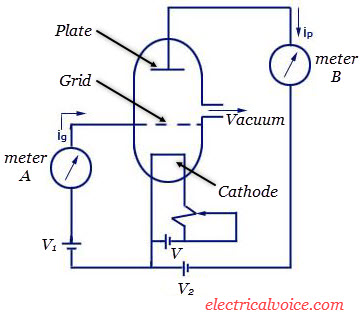Ionization type Vacuum gauge is a device which is used for the measurement of pressure in vacuum systems or in the very low-pressure region (below atmospheric pressure). It can measure pressure from 10-3 to 10-8 mm of Hg. Figure 1 shows the ionization type vacuum gauge.

The gauge consists of 3 electrodes i.e. cathode (heating filament), grid and plate and are enclosed in a glass vessel. The vessel is filled with a gas. There is an opening where a vacuum system is connected for which pressure is to be measured.
Working
The cathode (filament) is heated by a source. The electrons are emitted with high kinetic energy from the heated cathode. These highly energetic electrons are accelerated towards the grid (positively charged by source V1). Some of the electrons are captured by the grid and hence constitutes a current ig. The grid current (ig) is measured by meter A. The remaining electrons ionize the gas atoms. This will produce free electrons and positively charged ions. These positively charged ions are attracted by the plate (negatively charged by the source V2) and hence constitutes a current ip. The plate current (ip) is measured by meter B.
The pressure of the gas is proportional to the ratio of plate current (ip) to grid current (ig) and is given by

where S is the proportionality constant and is known as sensitivity of the gauge. S is a function of the geometry of the vessel and the gas-filled in it.
Disadvantages of Ionization type Vacuum gauge
1. The heating element (cathode) can burn quickly if heated when the pressure is not low.
2. Extra care needed while installing these gauges.
